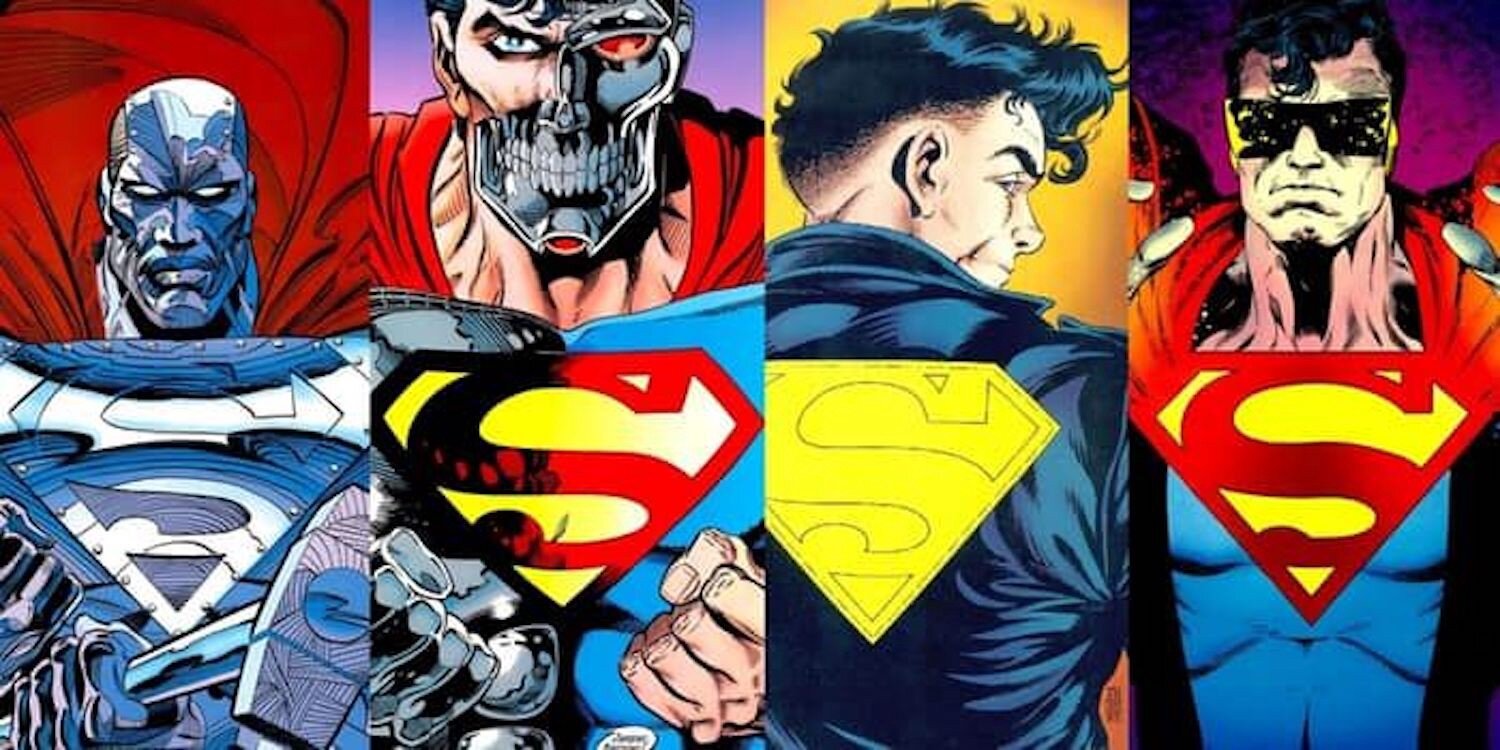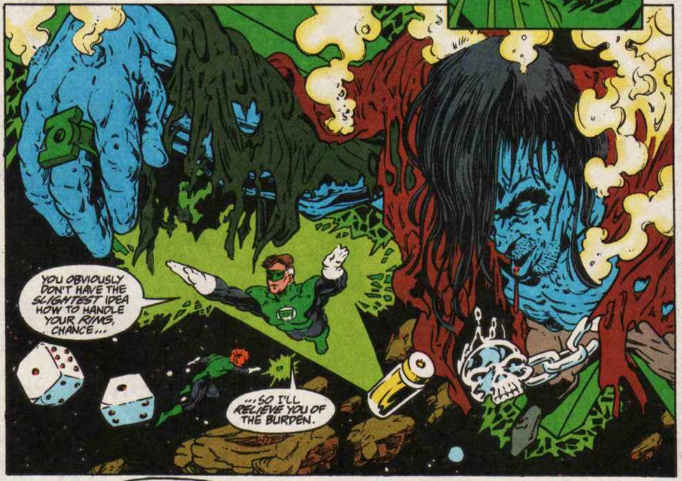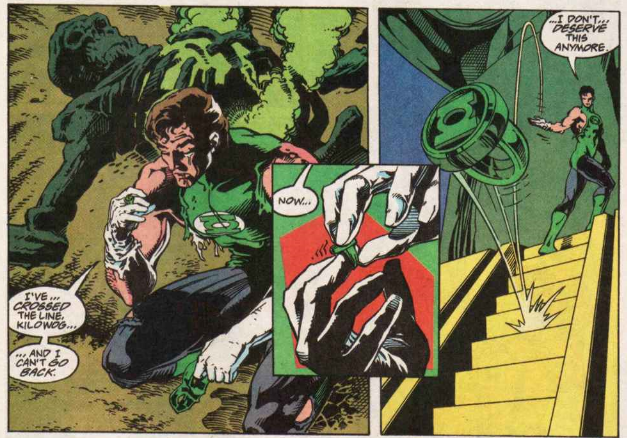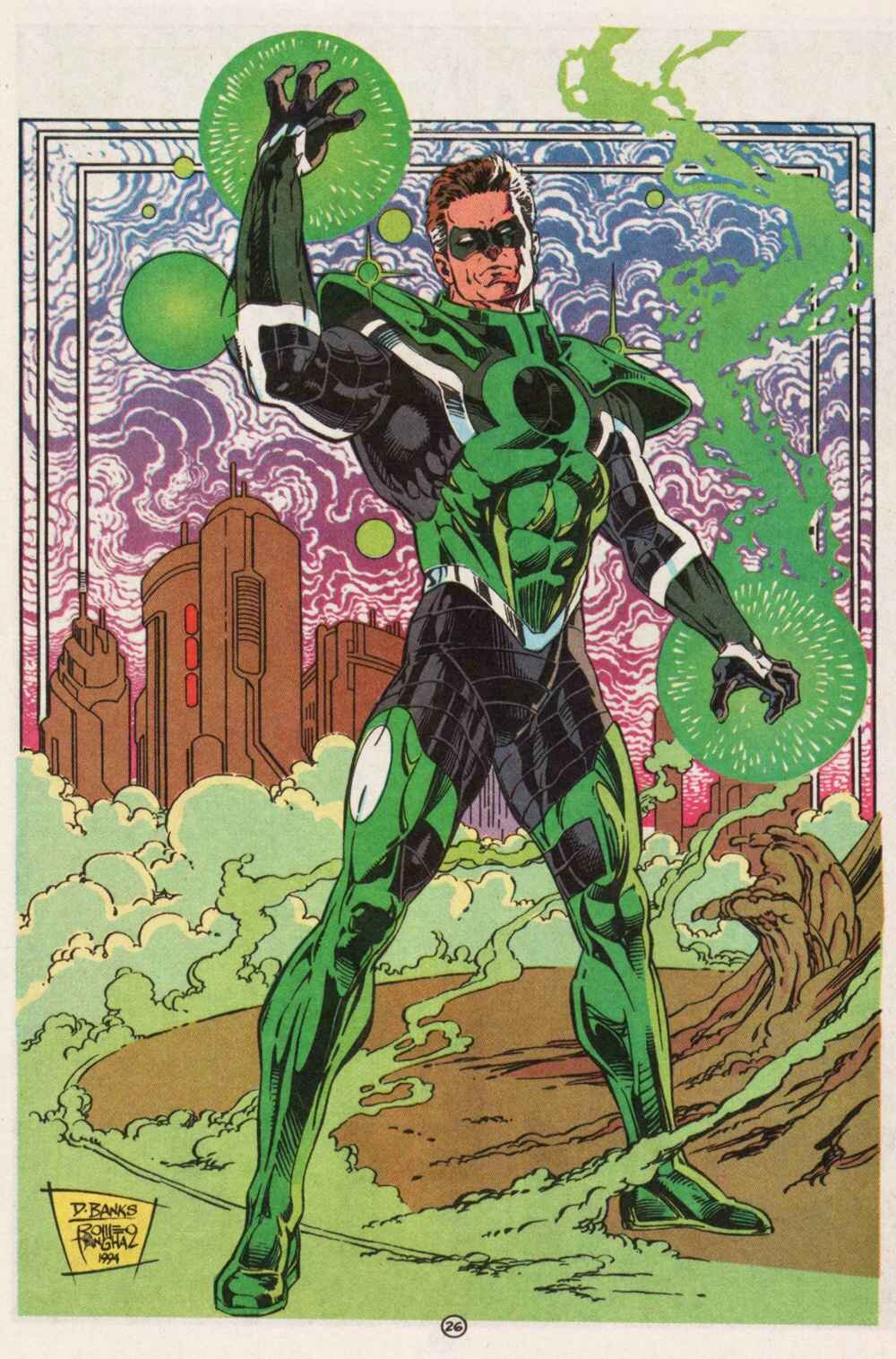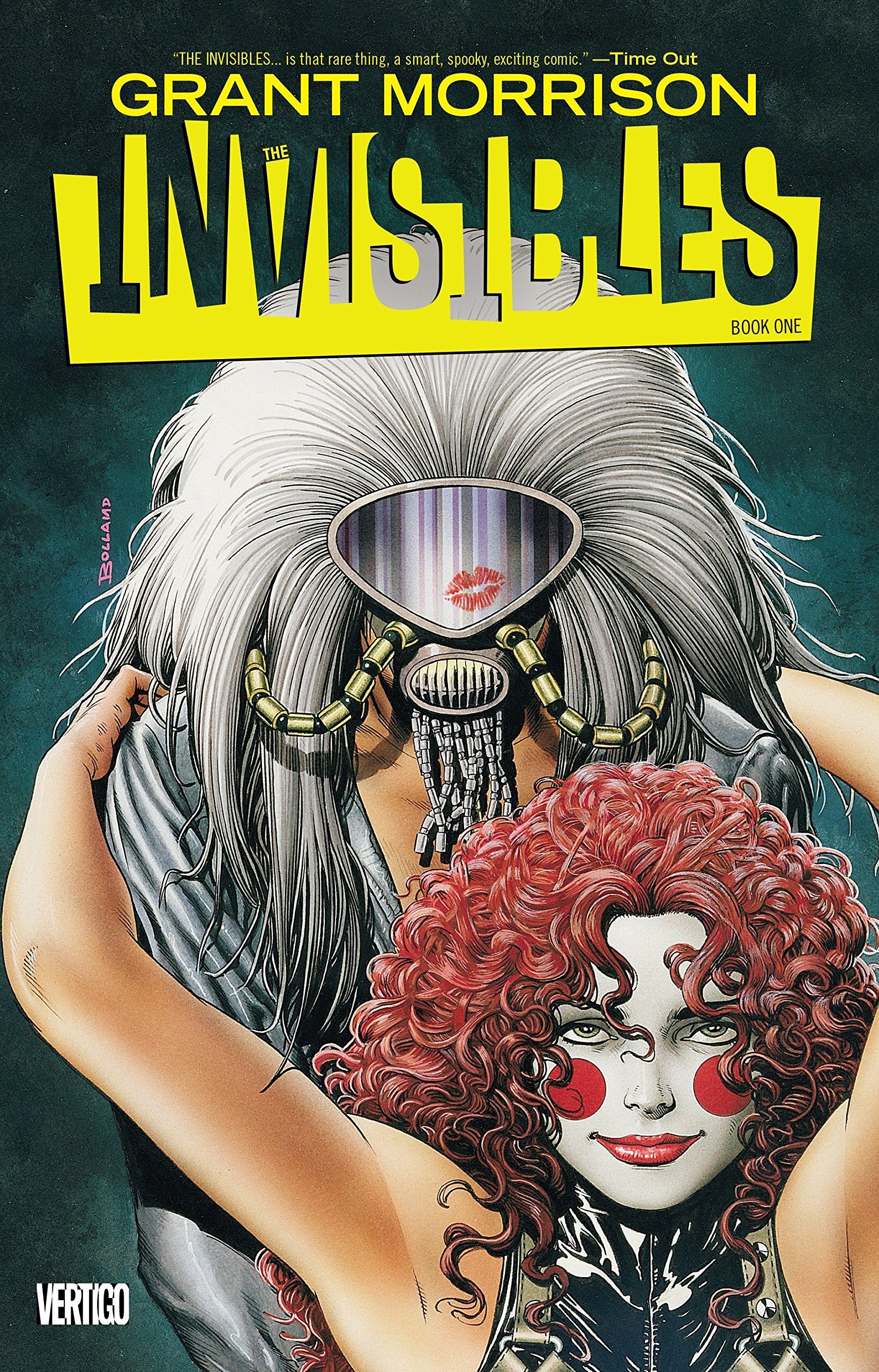Emerald Twilight: Fall of Hal Jordan // Comics 101
DC Comics was a font of change in the 90s. Having literally scrapped almost their entire universe back in 1986 to start over again and found a rather large amount of success, someone in editorial had the genius idea of letting characters expand, grow, and change. This also would involve legacy, which became a driving force of the company for a decade. A perfect example of this would be the Flash, where time travel helped flesh out over a thousand years of Flash family into the future. The years of 1992-1994 were also a bizarrely precise moment of change in the company as well.
Superman died at the hands of Doomsday. While it was a massive editorial delaying tactic and sales gimmick, the writers on the four Superman books at the time were also given fiat to examine what makes Superman a superhero, as well as what the DC Universe would be like without him. Some were explicitly written to undermine arguments for a "gritty" Superman, or for a "younger" Superman. This would last from late 1992 and stretch until the end of 1993.
Batman's back was broken at the hands of Bane, resulting in apprentice hero Jean-Paul Valley becoming a grimdark 90s version of the Batman. While the story began in 1993, the storyline would have Bruce replaced as Batman until August 1994. During the storyline, the writers would examine what makes a good Batman and what makes a good crimefighter, actually responding to fans who wanted a "darker" Batman back in the day.
With Batman and Superman temporarily replaced with fantastic sales for every book involved, editorial decided that another hero would be deconstructed. This time would be the "boring but cool uncle" of the DC Universe with slagging sales: Hal Jordan, the Green Lantern.
Green Lantern had basically avoided the full-fledged reboot of the Crisis on Infinite Earths. The book Green Lantern Corps had escaped a renumbering and continuity reboot, instead lasting until 1988's issue 224. In that final storyline, the Green Lantern Corps were basically depowered and reduced in number to become background characters in the DC Universe. While a few mini-series would be released to update Hal Jordan (and the Green Lantern) mythos for this new Post-Crisis universe, Hal wouldn't really show up until a relaunch in 1990 with Green Lantern.
The book would focus on Hal, though John Stewart would be given his own spinoff under Green Lantern: Mosaic, and Guy Gardener would hang around in the Justice League before getting his own book. Mosaic would eventually be canceled, and the sales for Green Lantern would slowly slip down as DC's sales, in general, seemed to flag in the early 90s. While the book was solid itself, it's hard to recommend people pick up the run for one solid reason: Writer Gerard Jones is currently serving a six-year sentence for possession of child pornography, beginning in 2018.
Why yes, Ollie. Someone has a serious problem with that.
Oi.
Gerard Jones was asked to come up with an idea to update Hal, similar to Superman and Batman, in his book. The Guardians of the Universe, the leaders of the Green Lanterns, would fight against a different force of Guardians, each claiming the other to be frauds. True to the book favoring Hal at the time, and Jones favoring Hal to an insane extent would be the sole person in the Corps who believe the original Guardians are the real deal. The end result would have Hal as the lone rebel fighting against an even more oppressive force of Green Lanterns led by his mortal foe Sinestro.
After his ring gets destroyed on the ruins of his hometown Coast City (more on that in a moment), Hal Jordan realizes that he has somehow internalized the power of the Green Lanterns. He uses this to fight against everyone and somehow restore the original Guardians. However, it would also be revealed that the original Guardians caused his father's death by intentionally killing him, causing trauma in young Hal Jordan's brain that would help him conquer great fear later. As such, Hal would leave the Corps and serve as his own hero, the working-title hero The Protector.
Jones' original plan would give Hal his own book under his new title, while another GL would take the core Green Lantern title. In theory, a new character. However, DC editor Kevin Dooley is attributed to striking this idea down because it wasn't good enough to attract new readers. Dooley would work with other editors to come up with a new plan. Instead, Gerard Jones would leave the book with issue 47, despite having written summaries and even partial art being taken care of for issue 48. The letter column would actually address this sudden swerve, by saying that there would be a 2-month gap between installments, and there wasn't even a cover preview.
Now, before we go into what new writer Ron Marz would be given to script, we should cover the setup for Emerald Twilight itself.
The Reign mentioned above of Supermen featured four Supermen intended to take the place of the then-dead Superman. One of them, a cyborg, would turn out to be a one-time enemy of Superman who took the Man of Steel's appearance with a Terminator flair. Part of his plan would be to work with some aliens to create a massive engine on the planet Earth to turn it into a traveling war planet. The location chosen was Green Lantern's hometown, the West Coast-based Coast City.
Yanno, DC really should come up with some more clever names for their fake cities.
Anyhow, Coast City was destroyed during a time where Hal was off-world fighting against a rival group of cosmic law enforcers, the Darkstars. His on and off again girlfriend Carol Ferris was able to survive through blind luck, along with his sidekick and friend Thomas "Pieface" Kalmaku. Almost all of Hal's civilian life was wiped off the planet beyond them. Issue 46 would show Hal get revenge against Mongul, the alien responsible for destroying Coast City itself.
Gerard Jones aside, this was an awesome page.
Issue 47 would have Green Arrow show up and help Hal rescue Carol from a threat introduced in the last chapter. In fact, the book ended with the idea that Hal was getting over his civilian life being wiped off the map. However, the ground floor of Hal Jordan's fall from grace began with issue 83 of Superman. A funeral was held for Coast City, attended by the Justice League, and Hal was decidedly on edge and aggressively wanting no one to forget the tragedy of Coast City. With some basic work laid, the entire book would be thrown onto its ear with issue 48 and writer Ron Marz's first issue.
Marz would be joined by an army of artists. Pencilers Bill Willingham, Fred Haynes, and Darryl Banks would all take an issue. Inkers would consist of Romeo Tanghal, with Robert Campanella and Dennis Cramer assisting. Colors would be provided by Anthony Tollin and Steve Mattsson. The lettering would be added by Albert de Guzman alone. What resulted was honestly some of the best art the Green Lantern book had seen in a decade.
Hal Jordan would be unable to "move past" his grief, it bubbling up from under any control he tried to exert on himself. At first, he would summon up his memories of his father, then his mother. They both ask him to move on, his subconscious begging him not to break any of the rules of the Green Lantern Corps, or to do anything stupid. For those who know Hal, he tends to do stupid things without thinking, and he does not listen to his memories of his parents.
Hal re-creates all of Coast City in shades of green. The result is remarkably idyllic, looking like something out of the 1950s, or Hal's childhood in this case. He even reconnects with a high school girlfriend, and his father is more supportive this time. Just before his father comments on how proud he is of Hal… the ring dies. Out of power.
One of the Guardians also shows up by projected image and lectures Hal for using the ring for personal gain. As such, the Guardians are going to have Hal arrested and take away his ring. They also say he will be jailed on their headquarters world of Oa. Now, someone who has lost a lot, and is known for making stupid decisions with the hope that things just work out, anyone care to guess what happens?
Ah, yes. Hal's sanity takes a rain check, and what I've come to call "Crazy Hal" takes over instead. The slippery slope is a rather steep one, as Hal's fall from grace needs to take place over three issues. Writer Ron Marz has said that the end result would be exactly the same if he had been given more issues, but it would have been more subtle than what we had. However, subtlety being thrown out the window is perfect for Hal's history, as those who remember Green Lantern / Green Arrow can attest.
Issue 49 opens with one of the most shocking covers in GL history to that point:
Yes, Hal Jordan with a baker's dozen of Green Lantern rings, and each looking to have been stolen from his former friends. There is a sharp corner we are fast approaching on this vehicle of a book, and the brakes have been snipped by editorial. The issue proper opens with Hal in open combat with several minor background Green Lanterns. Most of them were introduced during the recent run in the new Green Lantern book, including. This includes oddballs like Jack T Chance, the rebel Green Lantern who chose to use guns and was like a drunken Han Solo. Tomar Tu, an alien that Hal himself had recruited in the first story of the book a few years back, would also appear and be ended by Hal. However, Hal would refuse to kill… allegedly.
Instead, Hal Jordan would take their rings. Which, in the depths of space, should just kill everyone outright instead with sudden decompression. It would allegedly not, with the rings leaving just enough charge in the bodies of their former owners to spare them death. This would actually come back to haunt Green Lantern in a few years, believe it or not. Finally, however, Hal would come face to face with his closest non-Human friend in the Corps: the drill sergeant Kilowog.
It wouldn't last long.
However, with Hal looking to enter the central battery and take the entire power of the Green Lanterns for himself, the Guardians had one final card to play. Emerging from the central power battery is Hal's most deadly foe, once again clothed in green with a ring on his finger: Sinestro.
The final issue, the double-sized 50th issue, would premier with the final showdown between Sinestro and Hal Jordan. Sinestro would talk Hal down to one ring before the two would wind up in a fistfight. Unfortunately, despite having taken down an entire army in one-on-one combat, Hal Jordan would end Sinestro brutally and without regret.
However, before Hal could try to take all the power for himself, his old friend Kilowog would once again rise to his feet. Kilowog would try to beg for Hal's sense of reason to take back over, pointing out that any GL left in space would die once Hal claimed all the power to himself. This would also include those Hal abandoned without rings, but Hal's mind is set. He claims to have gone too far to turn back now, and he also uses lethal force on Kilowog.
As Hal enters the central battery, the Guardians all have a brief meeting. It is decided that this cannot be the end of the Corps and that one Guardian must be the one who carries on for the future. Ganthet, the Guardian with a ponytail, receives all the remaining power of the Guardians as the central battery explodes. What emerges from the remains is Hal Jordan, a changed being.
Hal crushes his former ring out of a mix of emotions and leaves, flying off into space to try and right the wrong-ness of this universe. However, the burned and desiccated bodies of the Guardians hide Ganthet from his eyes, and he takes the crumbled remains of the ring to re-forge it. Not wanting to waste his dwindling power, he turns into a green bolt of energy and heads off to Earth.
Now, I must confess, we haven't covered the entire story so far. Issue 47 ended with a brief interlude introducing us to an unnamed young man and his girlfriend. Upon seeing the shooting star of Hal Jordan traveling to Oa to wreak havoc, the young man wishes that he and his girlfriend had the power to get away, to escape their humdrum lives.
Young Kyle Rayner was about to get his wish, in the strangest way possible.
Ganthet would crash in an alleyway, providing Kyle the last Green Lantern ring in a briefing that would put video game crash courses to shame. After handing Kyle the ring and saying he must "take it," Ganthet melts into a puddle of green stone, and Kyle puts on the ring on to find himself the last Green Lantern.
These three issues would have a meteoric impact on the entirety of the DC Universe. Hal Jordan would take the (very 90s, but also very cool) name Parallax as his own, and try to convince his friends that the world needed to be fixed at any cost. This would result in the late-1994 DC line-wide event Zero Hour.
In Zero Hour, Hal would reach out with another hero-turned villain Extant (the former Hawk of Hawk and Dove, don't ask) and try to literally rewrite reality to make it favor the things they've lost. Hal would become a minor recurring villain in the pages of the cosmic DC heroes (and Justice League), a rather ignoble fate for a former founding member of the Justice League. Hal would also later sacrifice his life to reignite the sun in 1996's event Final Night.
There is one more aspect to speak about with this event, however. Thanks to the early days of the internet, the more toxic side of comic fandom was about to reveal their ugly heads. Calling themselves HEAT, Hal's Emerald Advancement Team would demand the reversal of editorial decisions revolving around Hal Jordan and the restoration of Hal as the premier Green Lantern. New lantern Kyle Rayner would either be left alone, depowered or "die in a fire." They would basically be obnoxious on early message boards surrounding DC comics, which seem to have been lost to time. The group was somehow passionate enough to take out a double-page ad in Wizard Magazine, the premier comic magazine back in the day. It's estimated this cost $3,500.00 at the time and was summarily mocked to hell by the same magazine.
The website still exists, actually. There are a few dead image links, and the guestbook seems to have died or broken. However, you can visit it here so long as Tripod still exists as a hosting service. It's a weird little snapshot into toxic fandom in the mid-90s… and was ultimately made redundant anyhow.
You see, Geoff Johns would bring Hal back in 2005 with what would be the start of what would be a swath of resurrecting Silver Age heroes and sidelining (or equaling) their legacy characters. Admittedly, Johns would have a fantastic comic run, going from 2005 to 2013, a modern record for most creators. Johns' run on Green Lantern would even survive a complete line-wide reboot in 2011's Flashpoint. Along with Batman, Green Lantern would literally be the only book to survive two massive reboots and still somehow be the same continuity from all the way back in the 1950s.
However, with Hal having returned back to comics only two decades later and having been back for 14, are these comics still worth looking at?
Most certainly, yes.
While lacking the political and social oomph of comics like O'Neill and Adams' Green Lantern / Green Arrow, these three issues are a fascinating view of a hero's descent into well-meaning madness and the lengths Hal Jordan can go when he believes he's right. While the core start of the event is found under an author with a troubling legacy and begins with another major event's ending, this was the first comic in decades to make Hal Jordan indeed a compelling character beyond "that guy who acts seriously under pressure." The idea that a hero could lose their way after such a tragic loss is rarely examined, with tragedy instead being often used as an origin story or a random way to raise the stakes with another villain.
While the original concept could have provided new story ideas, it's hard not to see how important these three issues wound up being for Green Lantern and DC Comics. Sometimes, comics don't need a massive message about being just.
Sometimes they just need to tell a damned good story and take chances.


